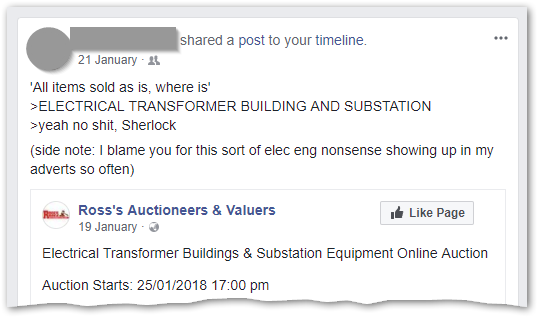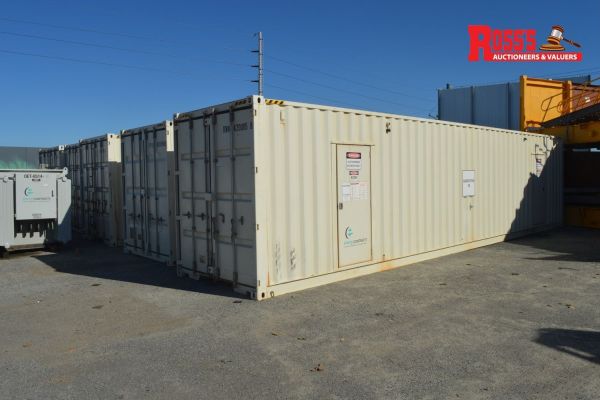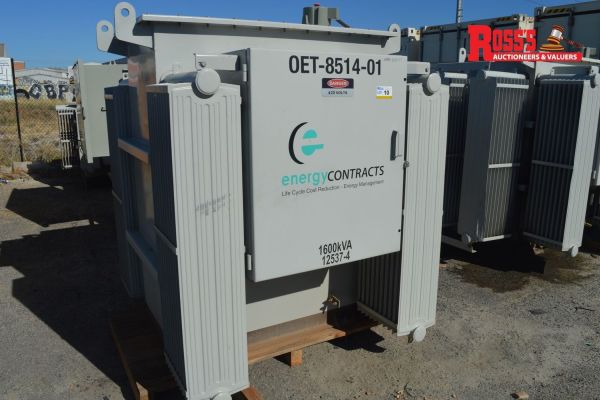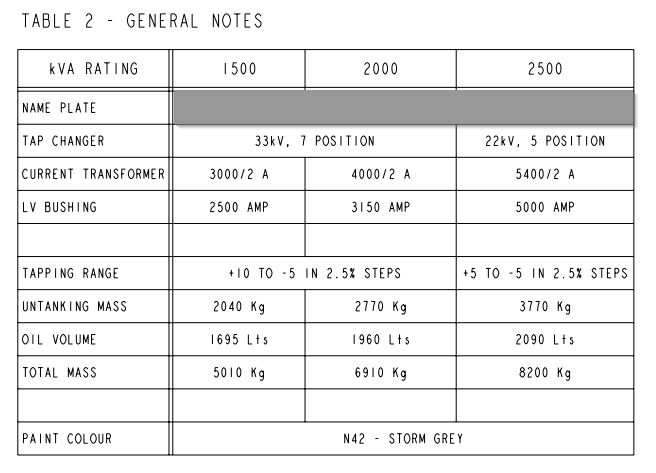Temporariness
Posted: , Updated: Category: EngineeringPeople see the world in different ways.
Things that seem permanent for some people, are considered temporary or easily changed by other people.

I guess the root of the above comment is:
This equipment is huge - it must be hard to move.
Of course they’re going to sell it ‘where-is’.
They aren’t going to move that stuff for you!"
The equipment in question was a number of containerised substations and a number of distribution transformers.
The substations were in 40-foot sea containers. There were four of the containerised substations.

The transformers were a variety of sizes, ranging from 1,500 kVA to 2,000 kVA. There looked to be about eight transformers.

Weights for such transformers are in the 5,000 kg to 7,000 kg range. (Typical data below.)

Most people think of this equipment this size as permanent - “I couldn’t move that.”
This is correct from their frame of reference - most people don’t have the equipment or knowledge required to move these sorts of loads.
In industry, however, this is a simple exercise in cranage and haulage.
A pick-and-carry crane ("Franna") can be driven to site on public roads, requires no set-up prior to lifting, and the smallest model lifts up to 15,000 kg. (Bigger versions are available up to 40,000 kg capacity.)
You can hire a Franna (and operator) for about $1,500 per 12-hour day.
We use a Franna for everything - erecting steelwork, loading cable drums onto stands, lifting steel covers into place, holding pipework steady while we bolt it on - everything.
The truck we use can haul 12,000kg on the back.
I haven’t looked up prices for hire of a truck, but I would imagine it’s about the same as the crane - $1,500 per day.
So, moving the four containerised substations and eight transformers would probably take two or three days, for an estimated cost of, say, $10,000. That cost is small, compared to the cost of the equipment itself. (Prices as new - $250,000 for each containerised substation, $100,000 for each transformer.)
This is one of the many things I had to learn when I shifted from an office-work job to a industrial-site job. Things I thought of as “difficult to move” or “difficult to lift” are, in fact, very easy to move. The trick is to have the right machinery and experienced operators to drive it.
There’s a lesson in here - things we think of as static and unchanging, or unchange-able, might be easy possible to change if we look at them from a different perspective.
Aside: A similar difference in perspective applies to metal working.
The stairs are mostly installed now: the handrails and a few other adjustments remain. The installation is taking a while, but that’s because the steel guys are super meticulous about the whole thing. Which is good! I’ve seen them de-weld and reposition mounts because one side of a 5’ step would be 1/8th inch higher than another.
One of the unexpected things about watching the steel guys work is how the solidity of metal means nothing to them. Most people think of metal as something hard and inflexible, but welders don’t. Which should be obvious in hindsight, I guess. But, for example, they have these saw-horses that are made of tube steel. And I can see how that came about: they needed some saw-horses; they had some steel. It took them 30 seconds to make them. And, an example with the stairs: the legs of the stairs’ landing platform have big threaded bolts for feet, to fine-tune the height of the legs for levelling. And there are these steel tube sleeves that go around the legs, that drop down and cover the bolts. So when they were moving this platform in, they had to flip it over, and they didn’t want the sleeves to fall off while they did this. Now to me, that job calls for duct tape. To them: they welded the sleeves in place, then de-welded them when they needed them to move again.
Also from jwz: ultra-durable prison toilets.
The new toilets are here, the new toilets are here!
Something that perhaps you didn’t know about toilets: though porcelain seems like pretty sturdy stuff, in a contest between a conventional toilet, and a conventional beer bottle dropped from shoulder height, the toilet loses. That is, the toilet breaks, not the bottle. That means that clubs are either replacing their toilets all the time, or (like the old DNA) they have cracked toilets swaddled in duct tape. Well, we solved this problem by getting expensive toilets that are utterly indestructible: they’re stainless steel prison toilets. Seriously: some of the line items on the feature list were “no crevices for hiding of contraband,” and “suicide proof!”
See also “ligature-proof furniture” for more fascinating reading.
Word of the day: Brinelling.